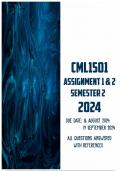, PLEASE USE THIS DOCUMENT AS A GUIDE TO ANSWER YOUR ASSIGNMENT
Please note that the author of this document will not responsibility for any plagiarizing you
commit.
Assignment 1 - Due: 16 August 2024
1.1. Write brief notes on THREE of the following:
A) The various types of licences available for broadcasting purposes.
Individual Licence: This type of license is issued to a specific broadcaster or operator. It is
often tailored to the particular needs and circumstances of the applicant and may include
specific terms and conditions related to the content, reach, or technical aspects of the
broadcasting service. Individual licenses typically involve a thorough vetting process and are
granted based on factors like the operator's qualifications and resources.
Class Licence: A class license is a more general broadcasting license that applies to a category
or class of broadcasters rather than a single entity. Broadcasters that fall under this category
can operate without needing to apply for an individual license. The conditions and
requirements for a class license are predefined, and as long as broadcasters adhere to these,
they are covered by the license. This type of license simplifies the regulatory process and is
often used for smaller or less critical broadcasting operations.
Exempt Licence: An exempt license allows certain types of broadcasting activities to be
carried out without the need for a formal license, typically because they are considered to be
low-risk or of minimal impact. For example, small-scale, non-commercial broadcasters, or
operators who only provide content within a very limited area or for a specific purpose, might
be exempt from licensing requirements. However, even under an exempt license, broadcasters
may still need to comply with certain basic regulatory standards.
(Study Guide - Page: 268)
B) Possible crimes that can be committed in respect of information on a computer network.
Hacking: Unauthorized access to computer systems or networks, often with malicious intent
such as stealing sensitive information, disrupting operations, or damaging systems. Hackers
may exploit security vulnerabilities or use social engineering to gain access to systems.
Phishing: A form of cybercrime where attackers deceive individuals into providing
confidential information, such as passwords or credit card numbers, by pretending to be a
legitimate entity. Phishing is commonly executed through fraudulent emails, websites, or
messages that appear trustworthy.
Distribution of Malware: The intentional spreading of malicious software, including viruses,
worms, and ransomware, to infiltrate and damage computer systems or networks. Malware can
be used to steal data, disrupt services, or extort money from individuals or organizations.
Attackers may distribute malware through infected email attachments, compromised websites,
or malicious downloads.
(Study Guide - Page: 304-305)




